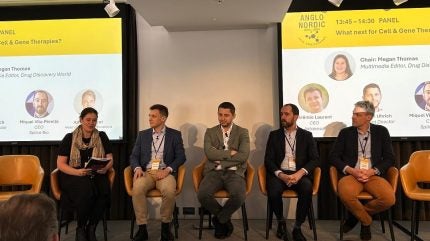“Lack of harmonisation in Europe” hindering gene therapy growth
18 Apr 2024
Gene TherapyCell Therapy

Preview
Source: Pharmaceutical Technology
The panel discussed the future of cell and gene therapies at the Anglonordic Life Science Conference on 18th April in London. Image credit: RobertBarrie/GlobalData.

Preview
Source: Pharmaceutical Technology
Amid a US regulatory landscape promoting collaboration in cell and gene therapy development, SpliceBio’s CEO Miquel Vila-Perelló has questioned why the same push is not occurring in Europe.
The Spanish biotech’s CEO was speaking on a panel discussing the trending treatment modality at the Anglonordic Life Science Conference taking place in London, UK, on 18 April.
Cell and gene therapies are some of the most promising treatment modalities emerging in the pharma industry. However, they are also amongst the most challenging to bring to market. Just under half of current clinical holds are for cell and gene therapy trials.
The US Food and Drug Administration (FDA) is keen to expedite the development of gene therapies and has issued draft guidance on a proposed platform technology designation programme. The programme, mandated by US Congress, is intended to speed up the review of drugs and biologics using the same advanced manufacturing technology.
Vila-Perelló said: “Whilst in the US advances are being made, this lack of harmonisation throughout Europe hampers [the cell and gene therapy space]. And it explains in part why there are fewer clinical trials in gene therapy [here].”
See Also:
Lirafugratinib hydrochloride by Relay Therapeutics for Human Epidermal Growth Factor Receptor 2 Negative Breast Cancer (HER2- Breast CancerHER2- Breast Cancer): Likelihood of Approval

Preview
Source: Pharmaceutical Technology
Inaticabtagene autoleucel by Juventas Cell Therapy for Acquired (Autoimmune) Hemolytic Anemia: Likelihood of Approval

Preview
Source: Pharmaceutical Technology
According to Arnaud Autret, principal and head of European operations at Illumina Ventures, regulatory frameworks – such as the FDA’s platform approach – will be key in the market’s future from an investment point of view.
Autret comments: “We need to have a supportive regulatory framework and adapt that framework to the continuous innovation we have in this space. Even for approved drugs, there’s still a lot of work to do around market access.”
Industry experts have already raised concerns about legislation in Europe creating barriers to cell and gene therapy access in the continent. Increasing competition from China and the US has also created a gap in R&D expenditure in the European cell and gene therapy sector.
The FDA’s Center for Biologics Evaluation and Research director Peter Marks has said global initiatives such as its Gene Therapies Global Pilot (CoGenT) scheme could help assess commercial viability and improve market access on an international level.
The panel discussion also focused on manufacturing and scalability – commonly cited as two of the biggest challenges currently facing cell and gene therapies as the modality begins to expand to treat more common conditions.
Jérémie Laurent, CEO of French biotech Astraveu, said that biological options that are more scalable, without compromising on quality or efficacy, will be a key feature going forward from an innovation angle. M Ventures investment director Christian Uhrich concurred, saying that the space will “deliver tremendous value” once these issues are overcome.
One consequence of immature manufacturing is sky-high costs for cell and gene therapy products. The most expensive drug was announced earlier this month – Orchard Therapeutics’ Lenmeldy for the treatment of metachromatic leukodystrophy listed at a staggering $4.25m.
Regarding a remedy, the panel agreed there is no “one size fits all” approach, with each type of cell and gene therapy requiring different processes. While regulatory agencies and reimbursement frameworks are progressing, whether these can keep up with the monumental strides occurring in biological innovation remains to be seen.
Cell & Gene Therapy coverage on Pharmaceutical Technology is supported by Cytiva.
Editorial content is independently produced and follows the highest standards of journalistic integrity. Topic sponsors are not involved in the creation of editorial content.
Free WhitepaperCell and gene therapies: Pipe dream to pipeline
The cell and gene industry is gaining momentum, with a new wave of therapies promising to transform the way doctors treat, and even cure, disease. In this report, Cytiva and GlobalData have collaborated to explore the rise of the cell and gene therapy industries, the current state of the market, present and future opportunities for advancement, and the challenges that lie ahead.

Preview
Source: Pharmaceutical Technology
-->
By downloading this case study, you acknowledge that GlobalData may share your information with Cytiva Thematic and that your personal data will be used as described in their Privacy Policy
For more details,please visit the original website
The content of the article does not represent any opinions of Synapse and its affiliated companies. If there is any copyright infringement or error, please contact us, and we will deal with it within 24 hours.
Organizations
Hot reports
Get started for free today!
Accelerate Strategic R&D decision making with Synapse, PatSnap’s AI-powered Connected Innovation Intelligence Platform Built for Life Sciences Professionals.
Start your data trial now!
Synapse data is also accessible to external entities via APIs or data packages. Leverages most recent intelligence information, enabling fullest potential.





